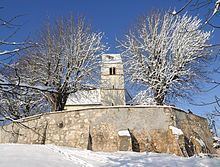Admin. region Freiburg Postal code 79539 Administrative region Freiburg | District Tüllingen Area 208 ha Dialling code 7621 | |
 | ||
Elevation 350 - 460 m m (Bad rounding hereFormatting error: invalid input when rounding ft) | ||
T rex 500 crash t llingen l rrach joan serra
Tüllingen (Alemannic Dialect|Alemannic: Düllige) is a district of Lörrach, Baden-Württemberg, Germany, located on "Tüllinger Mountain", (also "Tüllinger Hill", or just the "Tüllinger"). Upper and Lower Tüllingen were merged into the Tüllingen district in 1935.
Contents
- T rex 500 crash t llingen l rrach joan serra
- Location
- Neighbouring communities
- Geology and agriculture
- History
- Public buildings
- Emblem
- Infrastructure
- Well known inhabitants
- Literature
- References
Location
Tüllingen is a small village in the southwestern region of Germany in Baden-Württemberg. Its coordinates are: Latitude 47°36'07.6"N (47.6021100°), Longitude 7°38'39.3"E (7.6442500°). The Tüllinger Mountain (In Switzerland called Tüllinger Hill) is of geological importance, elevated above the southern part of the city up to a height of 460.2 m above sea level (NHN) . It offers a view of the tri-border area as well as the so-called Rhine-Knee and surrounding cities like Lörrach, Weil am Rhein and Basel
Today, large areas of the Tüllinger have been declared a special area of conservation in order to preserve a space for local recreation. Subsequently, the mountain has been designated as a protected area by the Habitats Directive. Due to the region's mild climate, the southwestern slope of the mountain is optimal for growing grapes, which are popular for regional products such as Markgräfler Wine. Additionally, the exposed position of the mountain allows many weather stations to measure data for the weather forecast. A small part of the Tüllinger above the former public swimming pool in Riehen, "Im Schlipf", is Swiss territory.
Neighbouring communities
In the south, Tüllingen shares a border with another village called Riehen, which is located on the Swiss border. The district of Stetten is located southeast of Tüllingen. Further north is the center of Lörrach. North of Tüllingen lies Tumringen, as well as Ötlingen and Haltingen, which are districts of Weil am Rhein. Situated to the southwest of Tüllingen is Alt-Weil (Old-Weil), which is situated on the hillside.
Geology and agriculture
Tüllinger Mountain is situated predominantly in the Tüllinger softwater molasse. The molasse comprises of vryenen marl and parts of the Alsace molasse. The mountain was created through a fracture zone. The soil at Tüllinger Mountain comprises of loess, clay-saboulous, and chalky soils, which allows it for the cultivation of grapes and other fruit. Closed vine-areas are located in the south between Baselweg, Lichsenweg, and the lower Wagenkehrweg in the direction of Alt-Weil.
History
The first documented mention of Tüllingen dates back to the year 1113 when Walcho von Waldeck donated his possessions to the St. Blaise Abbey, indicating that the settlement's name possibly derived from a personal name. In 1173 the village is mentioned in a writ of protection addressed to St. Blasien by the then Pope Callixtus III., in which the Tüllinger Churches' possessions are named. The village has developed into becoming the road to Rötteln.
Tüllingen was, among other villages, affected by the Thirty Years War and the destruction of Rötteln in 1679 by French troops. On October 14, 1702, the Battle at Käferholz heavily damaged the village. In 1767 public water supply came from a new source, discovered between Higher- and Lower-Tüllingen. The same year, the borders to Rötteln were confirmed. In the 17th and 18th century, disputes of allegiance occurred between Tüllingen and neighbouring communities.
Tüllingen officially became a district of Lörrach on October 1, 1935.
Public buildings
The children's home "Kinderheim Tüllingerhöhe" can be found in Higher Tüllingen. The Protestant church is responsible for the home. The children's home consists of an administration block, a canteen kitchen, a basic primary school, a secondary modern school, a special school and a junior high school that goes until the 7th grade. Additionally, there are eight living-groups, therapy facilities, a gym and a sports field. Two of the living-groups belonging to the children's home live in Lower-Tüllingen. The old St.Ottilien Church in Higher Tüllingen is illuminated and visible from afar in the evening. The Lörrach Channel is also located in Higher Tüllingen.
Emblem
The Emblem of Tüllingen consists of two crossed golden swords on a blue background. It was introduced in 1901 in memory to the Battle of Friedlingen on October 14, 1702.
Infrastructure
Lörrach and Weil am Rhein are separated by the Tüllinger Mountain, a winding road leading over the Tüllinger Mountain, and a railroad tunnel, built between 1888 and 1890. For decades, the communities had tried to settle an agreement on a tunnel that goes through Swiss territory in order to bypass the road over the Tüllinger Mountain. In October 2013, the "Zollfreie" was opened (literally: "toll-free").
